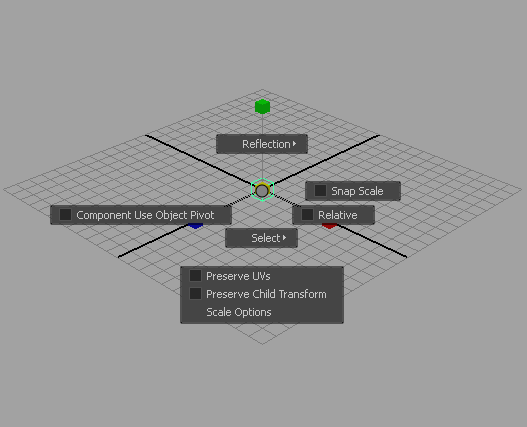Shows a scale manipulator on the selected objects or components.
options
Choosing a coordinate system for the Scale Tool
Use the window to specify the coordinate system () for the .
Note
Unlike the , you can only key scale operations in space.
Note
When you scale an object on all 3 axes simultaneously, the transformation always occurs in space, regardless of the current setting.
Note
You can only scale objects without components (for example, joints) in space.
-
-
Scales an object in object space coordinate system. Axis orientation includes rotations on the object itself. If several objects
are selected, each object scales the same amount relative to its own object space coordinate system.
-
-
Aligns the object to the rotation of the parent object. Scaling is constrained to those axes in the local space coordinate
system. The object is aligned to the rotation of the parent object and does not include the rotations on the object itself.
If several objects are selected, each object scales the same amount relative to its own object space coordinate system.
-
-
Scales in the world space coordinate system. The object is aligned to the world space axis. This is the default.
-
-
Scales selected vertices or CVs in the U or V direction of the surface. Typically you would use this option for small sets
of CVs. The manipulator indicates the surface Normal, U, and V directions.
-
-
Aligns to the’s axes on the object. If you have set the in the object’s to a different value (which offsets the orientation of the object relative to the orientation of the object's local rotation
axis) this attribute will have an affect; otherwise, is the same as Object.
-
-
Scales selected vertices or CVs along the average of their combined normals.
-
-
(This setting does not work with on.) Sets the to move objects along the axis of a live object. Most commonly, you would make a construction plane live, but any object
can be set live. When you have a live object and select this option, the move arrows of the align to the live construction plane. (The geometry of the live object doesn’t matter; the move aligns to the axes of the
live object.)
-
-
Enter the x, y, and z offset of the custom axis in radians.
-
-
You can set the to scale the selected object along a axis defined by selecting a point.
-
-
You can set the to scale the selected object along an axis defined by an edge.
-
-
You can set the to scale the selected object along an axis defined by an face.
Choosing a scale mode
You use the window to specify the behavior for the . You can also use the marking menu when scaling. Press the letter r and  over a selected object to display the following marking menu.
over a selected object to display the following marking menu.
-
-
Lets you scale object components about the object’s pivot point.
-
-
Lets you scale the selected objects about each object's individual pivot point.
NoteIn component selection mode, all objects scale about a pivot point in the center of the selection.
-
-
Lets you scale the selected objects about each object's individual pivot point.
-
-
Lets you scale all selected objects using the manipulator as a pivot point.
-
-
When this option is selected, moving a parent object does not move its children.
-
-
When this option is selected, moving components in the scene view causes the corresponding UVs to move accordingly in the
UV space. The net result is that the texture does not become warped.
-
-
The setting enables the option and lets you specify the amount an object is scaled in increments (determined by the value).
-
-
While Maya scales the object, relative spacing is maintained. Turn this option off if you don’t want to preserve relative
spacing while scaling.
-
-
Enter a value to determine the amount an object is scaled in increments when the option is selected.
Common Selection Options
-
-
Determines what happens when you drag the mouse in the scene panel.
-
-
When you drag the mouse in the scene panel, a marquee appears. When you release the mouse button, components within the marquee
are selected.
-
-
When on, you can only select components that are not obstructed by other components relative to the current camera.
-
-
When you drag the mouse in the scene panel, components under the cursor are selected.

 over a selected object to display the following marking menu.
over a selected object to display the following marking menu.
